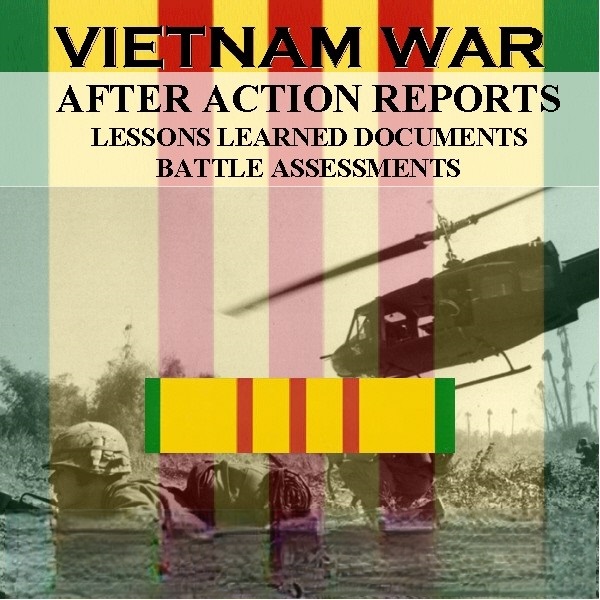
Vietnam War: After-action reports, lessons learned, and battle assessments
$0.00
Description
Vietnam War: Key Events and Personnel (1962-1972)
Timeline of Main Events (May 1962 – March 1972)
This timeline is constructed from the provided excerpts, focusing on specific operations, battles, and periods highlighted in the documents.
- May 1962 – March 1972: Period covered by the United States Military documents compilation, including After Action Reports, Lessons Learned Bulletins, and Battle Assessments related to combat activity during the Vietnam War.
- March 1962 – October 1970: Period covered by the Lessons Learned Bulletins, which incorporated knowledge from After Action Reports and personal observations of combat situations.
- February 17, 1963: After Action Report for the 5th Special Forces Group covers the establishment of the Civilian Irregular Defense Group.
- October 1964: Republic of Vietnam Logistical System Staff Study published, indicating analysis of the South Vietnamese logistical capabilities.
- January 6 – March 28, 1967: Period of U.S. Army Mechanized and Armor Combat Operations in Vietnam (MACOV), summarized in a report from March 1967.
- 1967: Enemy Jungle Tactics for Platoon Leaders Handbook published in Vietnam, indicating a focus on disseminating knowledge about Viet Cong tactics to U.S. platoon leaders.
- January 18 – February 12, 1968: Operation CORONADO X: The 2nd Brigade of the 9th Infantry Division launched riverine operations in the Mekong Delta. The operation’s focus shifted to crushing the Tet Offensive after Viet Cong violations of the lunar new year truce.
- January 30, 1968: The U.S. Military Assistance Command and the joint General Staff of the Republic of Vietnam officially terminated the cease-fire due to widespread truce violations. In Hue, Brigadier General Ngo Quang Troung implemented increased security measures and alerts.
- January 31, 1968: At 0340 hours, the North Vietnamese initiated a coordinated rocket, mortar, and ground assault against Hue, capturing most of the city south of the Perfume River and a large part of the Citadel.
- February 1, 1968: Vietnamese forces began offensive operations to clear the enemy from the Citadel, while U.S. Marines focused on securing the area south of the Perfume River.
- February 2, 1968: The 3rd Brigade, 1st Cavalry Division, moved into the Hue operations area to seal off the city to the west and north.
- February 2-26, 1968: The Battle of Hue: A bitter urban battle involving four U.S. Army battalions, three U.S. Marine Corps battalions, and eleven Vietnamese battalions against ten North Vietnamese and Viet Cong battalions. The battle resulted in extensive damage and significant civilian casualties.
- March 1968: Know Your Enemy the Viet Cong Pamphlet published, indicating ongoing efforts to educate U.S. troops about their adversary.
- September 1968: Army in Vietnam, Troop Topics Pamphlet published.
- Up to June 30, 1968: Period covered by the Command Report on the War in Vietnam by Admiral U. S. Grant Sharp and General William C. Westmoreland.
- May 11, 1969: Battle of Dong Ap Bia (Hamburger Hill): A battalion of the 101st Airborne Division encountered the 28th North Vietnamese Regiment on Hill 937, initiating a ten-day fierce battle for the heavily fortified hill.
- May – July 1969: Period covered by the Operational Report – Lessons Learned, 101st Airborne Division, which includes details of Operations Kentucky Jumper, Massachusetts Striker, Bristol Boots, Apache Snow, Campbell Streamer, and Montgomery Rendezvous.
- May 1969: Operation Apache Snow: A major air mobile operation targeting the A Shau Valley, a long-held North Vietnamese Army bastion along the Laotian border, leading to intense fighting.
- February 1972: Enemy Order of Battle Summary, Vietnam, Volume II published, containing retroactive data on enemy strengths and infiltration.
- March 1972: Enemy Order of Battle Summary, Vietnam, Volume I published, providing current data on enemy personnel and units.
Cast of Characters and Brief Bios
- Ngo Quang Troung: Brigadier General commanding the 1st Vietnamese Army Infantry Division. He improved security measures and increased readiness in Hue prior to the North Vietnamese assault in January 1968.
- U. S. Grant Sharp: Admiral and Commander in Chief Pacific (CINCPAC). Co-authored the Command Report on the War in Vietnam (to Mid-1968), providing CINCPAC’s perspective on the air and naval campaign against North Vietnam and Pacific Command-wide support efforts.
- William C. Westmoreland: General and Commander, United States Military Assistance Command, Vietnam (COMUSMACV). Co-authored the Command Report on the War in Vietnam (to Mid-1968), offering COMUSMACV’s command account of the war in South Vietnam.
- Unnamed Commander of the 101st Airborne Division: Defended the operation on Hamburger Hill (Battle of Dong Ap Bia), stating that the mission was to destroy enemy forces found on the hill, regardless of its strategic value.
This list includes the principal individuals specifically mentioned and whose actions or roles are detailed within the provided excerpts. There are undoubtedly many other key figures involved in the events described.
Vietnam War After Action Reports Lessons Learned Document Battle Assessments
3,200 pages of United States Military documents dating from May 1962 to March 1972 composed of after actions reports, lesson learned bulletins, and other reports dealing with assessment of combat activity during the Vietnam War
LESSONS LEARNED BULLETINS
1,600 pages of lessons learned reports dating from March 1962 to October 1970. Lesson Learned Bulletins incorporated knowledge gained from After Action Reports and by personal observations of combat situations during the Vietnam War. Topics include: Instructions for searching villages, psychological warfare, use of military dogs, deploying land mines, Viet Cong tunnels, booby traps, friendly fire, Vietnamization, use of the Mighty Mite Portable Blower, ambush, counter-ambush, search and destroy operations, naval gunfire support, use of napalm, and more. Information gained from after action reports for Vietnam War operations such as Operation Jungle Jim, Operation Dan Tien VIII, Operation Ca Chep, Operation Tiger Hunt, Operation Raindrop, Operation Nguyen Hue, Operation Son Ca, Operation Sunrise, Operation Harvest Moon, Battle of Xy Phu, Operation Happy Valley, Battle of Vinh Lot Island, Battle of Long Khot, Operation Hoai An, Operation Makalapa, Operation Hoai An, and more.
KEY AFTER ACTION REPORTS
Reports include:
After Action Report for 5th Special Forces Group – February 17, 1963: This Report covers the establishment of Civilian Irregular Defense Group.
After Action Report for Operation CORONADO X, January 18 through February 12, 1968: Just before the 1968 lunar new year (Tet) truce, the 2nd Brigade of the 9th Infantry Division launched riverine operations in the marshlands of the Mekong Delta under the code name CORONADO X. An Army-Navy mobile riverine force searched out the Viet Cong’s main force and local battalions in a combination of riverine, search and destroy, patrolling, and interdiction operations. When the Viet Cong violated the temporary truce by attacking eight major cities in the delta, the mission of the mobile riverine force was refocused toward crushing the Tet offensive. In Operation CORONADO X new equipment and techniques had to be developed for tactical mobility and fire support in the delta area, where conventional techniques were only marginally effective. The terrain was, for the most part, inundated. Swamps, rice paddies, irrigation ditches, rivers, and canals, while inhibiting the mobility of regular U.S. forces, had been used to advantage by the enemy.
After Action Report, The Battle of Hue, 2-26 February 1968: Hue was the third largest city in South Vietnam. It was a hundred kilometers south of the demilitarized zone and ten kilometers west of the coast. The Huong or Perfume River, running from the southwest to the coast, divided the populated area. The Citadel, a walled city of about three square kilometers and comprising about two-thirds of the city, lies on the north bank, and the other third of the city lies on the south. A railroad bridge on the west and the Nguyen Hoang Bridge, over which Route 1 passes, connect the two sections. The Citadel is surrounded by rivers on all four sides. It is further protected by a moat which encircles perhaps 75 percent of the interior city. The moat is reinforced by two massive stone walls.
Because of the widespread truce violations, the U.S. Military Assistance Command and the joint General Staff of the Republic of Vietnam officially terminated the cease-fire on 30 January. In northern I Corps, Brigadier General Ngo Quang Troung, the commanding general of the 1st Vietnamese Army Infantry Division, improved security measures and instituted a series of alerts which placed his units in a state of increased readiness. As a result, the division headquarters in the northeast comer of the Hue Citadel was on alert on 30 January. At 0340 hours, 31 January, the North Vietnamese initiated a closely co-ordinated rocket, mortar, and ground assault against Hue. Attacking with seven to ten battalions.
Under concealment of low fog Viet Cong and North Vietnamese units were able to infiltrate the city of Hue with the help of accomplices inside. The troops quickly captured most of that portion of the city on the south bank of the Huong River and seized the greater part of the northern half including the Imperial Citadel. While the division staff of the 1st Vietnamese Army Division was on 100 percent alert at the division compound in the northeast corner of the Hue Citadel, only a skeleton staff of the U.S. Advisory Team of the Vietnamese Army 1st Division was on duty at 1st Division Headquarters in the Citadel. The remaining members were pinned down in the Military Assistance Command Vietnam, compound in southern Hue by the initial Viet Cong and North Vietnamese assaults.
As daylight broke over the embattled city, the Viet Cong and North Vietnamese had control of all but the northern corner of Hue. The red and blue banner with the gold star of the Viet Cong could be seen flying in the Citadel flag tower. On 31 January, the mission of the Marines was altered, giving the 1st Vietnamese Army Division, which was in an area on the north side of the river, responsibility for that area. While two battalions of the 3d Vietnamese Army Regiment moved east along the northern bank of the Huong River, two Vietnamese Army Airborne Battalions and the Cavalry Troop fought their way into the 1st Vietnamese Division Headquarters compound in the northeast corner of the Citadel. On 1 February, the Vietnamese forces initiated offensive operations to clear the enemy from his entrenched positions inside the Citadel, and the marines opened operations to clear their area south of the river with particular attention to securing the landing craft ramp. The following day, the 3d Brigade, 1st Cavalry Division, moved into the operations area to seal off Hue City along the west and north.
The recapture of Hue was a particularly bitter fight. The battle had formed with four U.S. Army battalions, three U.S. Marine Corps battalions, and eleven Vietnamese battalions on one side and ten North Vietnamese and Viet Cong battalions on the other. It involved house-to-house fighting similar to that in Europe a quarter of a century before. There was extensive damage to the city where some 116,000 civilians became homeless. It was an expensive battle in terms of human life. The North Vietnamese and Viet Cong lost 5,000 soldiers within the city and an additional 3,000 in the surrounding clashes. An extremely harsh price was the loss of life among the civilian population. This loss was the direct result of a systematic selection process followed by the North Vietnamese and Viet Cong during the 26 days they occupied the city. In the wake of the offensive 5,800 civilians were dead or missing. More than 2,800 of these persons were found in single or mass graves during the months following the attack. Many of these victims were chosen because of their positions and loyalty to the Saigon government.
Battle of Dong Ap Bia, AKA Hamburger Hill, Summary Report, 101st Airborne Division, May 1969: On 11 May 1969, a battalion of the 101st Airborne Division climbing Hill 937 found the 28th North Vietnamese Regiment waiting for it. The struggle for “Hamburger Hill” raged for ten days and became one of the war’s fiercest and most controversial battles. Entrenched in tiers of fortified bunkers with well-prepared fields of fire, North Vietnamese and Viet Cong forces withstood repeated attempts to dislodge them. Supported by intense artillery and air strikes, Americans made a slow, tortuous climb, fighting hand to hand. By the time Hill 937 was taken, three Army battalions and an ARVN regiment had been committed to the battle. Victory, however, was ambiguous as well as costly; the hill itself had no strategic or tactical importance and was abandoned soon after its capture. Critics charged that the battle wasted American lives and exemplified the irrelevance of U.S. tactics in Vietnam. Defending the operation, the commander of the 101st acknowledged that the hill’s only significance was that the enemy occupied it. “My mission,” he said, “was to destroy enemy forces and installations. We found the enemy on Hill 937, and that is where we fought them.”
OPERATION APACHE SNOW AFTER ACTION REPORTS
238 pages of after action reports dealing with Operation Apache Snow. Operation Apache Snow, one of the largest air mobile operations of the Vietnam War. Operation Apache Snow was a direct attack into the A Shau Valley, a long-held bastion of the North Vietnamese Army (NVA) along the Laotian border. The NVA had two choices: 1) abandon their arms caches, as well as their base camps, and flee to Laos; or 2) stand and fight. They chose to stand and fight. This set the stage for the toughest single battle of the Vietnam War.
Other Reports Include:
Command Report on the War in Vietnam (to Mid-1968) : This is a report on the Vietnam War by Admiral U. S. Grant Sharp, Commander in Chief Pacific (CINCPAC), and General William C. Westmoreland, Commander, United States Military Assistance Command, Vietnam (COMUSMACV). It covers events up to 30 June 1968. The report is in four parts: CINCPAC’s account of the air and naval campaign against North Vietnam, Pacific Command-wide efforts in support of the war, COMUSMACV’s command account of the war in South Vietnam, and a prologue that welds the other three parts together.
Mechanized and Armor Combat Operations in Vietnam, March 1967. This report summarizes the operations and training aspects of U.S. Army Mechanized and Armor Combat Operations in Vietnam (MACOV) conducted during the period 6 January to 28 March 1967. Oriented on U.S. Army Mechanized Infantry, Tank, and Armored and the Air Cavalry.
Operational Report – Lessons Learned, 101st Airborne Division, May-Jul 1969 This report includes the chronological sequence of combat operations for the period 1 May to 31 July 1969. Includes the operations Operation Kentucky Jumper, Operation Massachusetts Striker, Operation Bristol Boots, Operation Apache Snow, Operation Campbell Streamer, and Operation Montgomery Rendezvous.
Enemy Tactics and Strengths Publications include:
Republic of Vietnam Logistical System, Staff Study, Oct 1964
Know Your Enemy the Viet Cong, Pamphlet, Mar 1966
Enemy Jungle Tactics for Platoon Leaders, Handbook, Vietnam (1967) – From the introduction, “This handbook is an attempt to familiarize platoon leaders operating in the jungle with the common tactics employed by the enemy in the Jungle. The information is general in nature and was derived from interviews with knowledgeable platoon leaders who were forced to learn many of these oft-repeated tactics through experience. It is hoped that this handbook will provide some understanding of these enemy tactics and equip the platoon leader to make more intelligent assessments of situations he is likely to encounter.”
Army in Vietnam, Troop Topics Pamphlet, Sep 1968
Enemy Order of Battle Summary, Vietnam, Feb 1972 – Volume II contains information on retroactive strengths, infiltration, and infrastructure for all months prior to the current month.
Enemy Order of Battle Summary, Vietnam, Mar 1972 – Volume I contains data on enemy personnel and listing of accepted units for the current month.
Related products
-
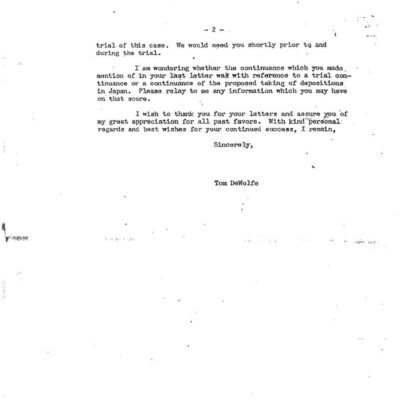
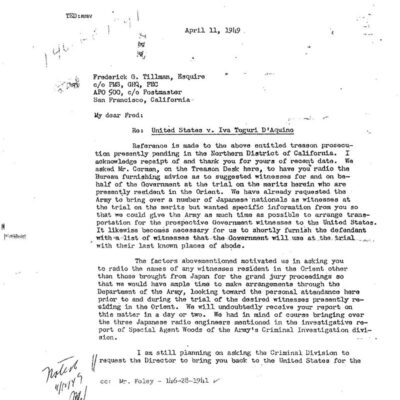
Tokyo Rose: Department of Justice Prosecution Files
$19.50 Add to Cart -
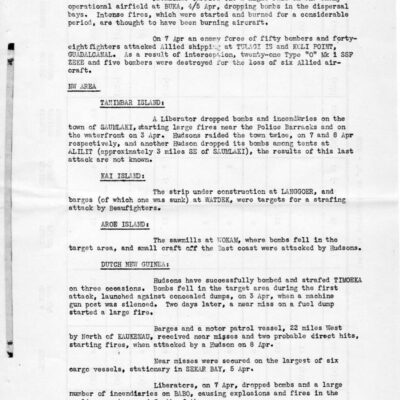
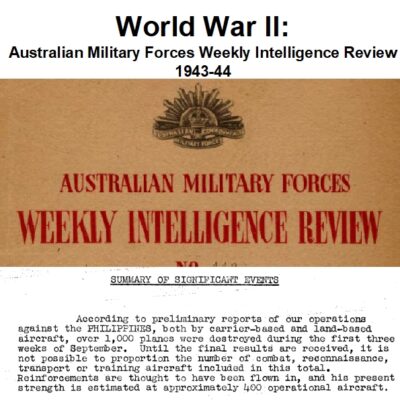
World War II: Australian Military Weekly Intelligence Reports 1943-44
$3.94 Add to Cart -
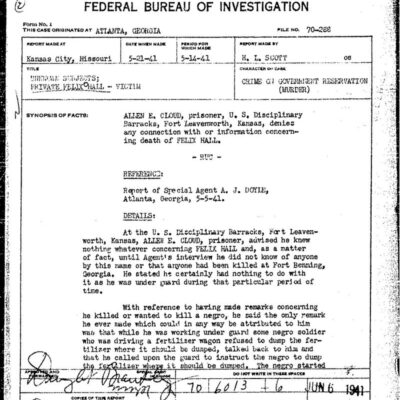
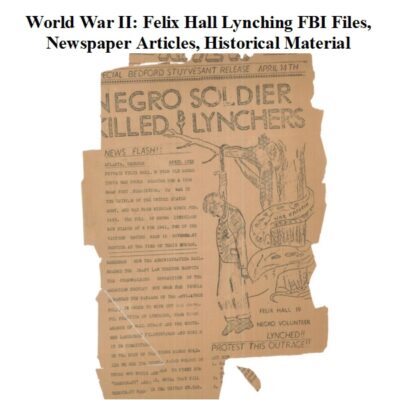
World War II: Felix Hall Lynching – FBI Files, Articles, Historical Records
$9.99 Add to Cart -
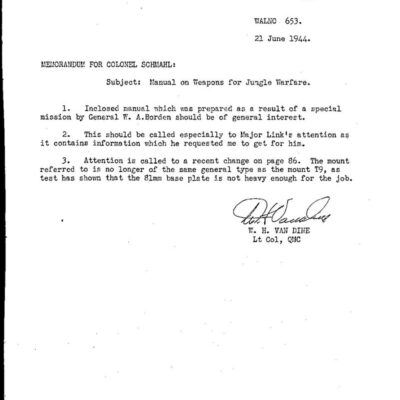
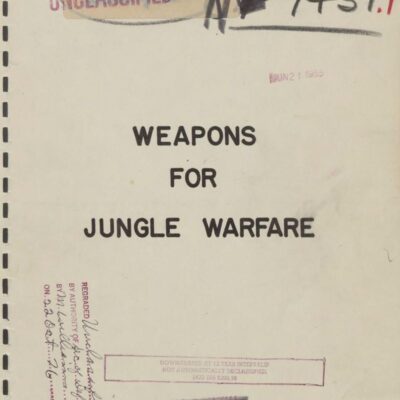
World War II Manual on Weapons for Jungle Warfare (1944)
$1.99 Add to Cart